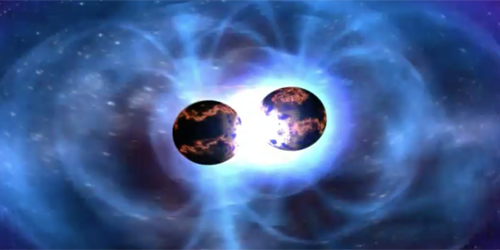Gravitational Waves Shed Light on Dense Nuclear Matter
In 2017, the Laser Interferometer Gravitational-Wave Observatory (LIGO) Scientific Collaboration along with the Virgo Collaboration made the first observation of the gravitational waves generated by the merger of two neutron stars. The gravitational waveforms also provided information on each star’s properties, such as its mass and its “tidal deformability”—the stiffness of a star in response to the stresses caused by its companion’s gravitational field. Two independent studies have now demonstrated that these gravitational-wave-derived properties can be used to extract information on the state of the matter that makes up the core of a neutron star.
Nuclear physicists have long sought to derive an “equation of state” (EoS) that describes dense nuclear matter, such as that found inside a neutron star. Such an EoS, based on fundamental nuclear physics parameters, would predict, among other things, the stellar mass-radius relationship and the maximum possible mass of the star. Because of the complexity of dense nuclear matter, and the dearth of experimental inputs, many EoS’s are possible, and their predictions for some parameters can disagree by up to a factor of 10.
The studies by Farrukh Fattoyev, at Indiana University in Bloomington, and co-workers and by Aleksi Kurkela at CERN, Switzerland, and co-workers have used the tidal deformability determined by LIGO and Virgo to significantly restrict the family of allowed EoS models. The two teams derive similar constraints. They show, for instance, that the correct EoS must predict a radius smaller than about 14 km for a 1.4-solar-mass star. Fattoyev et al. also examine a crucial EoS parameter called the nuclear symmetry energy—the change of binding energy of a nucleus as the proton-to-neutron ratio is varied. The team puts new limits on the nuclear symmetry energy's dependence on the density of nuclear matter, which has not been well determined by experiments.
This research is published in Physical Review Letters.
–Matteo Rini
Matteo Rini is the Deputy Editor of Physics.





